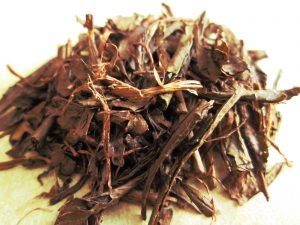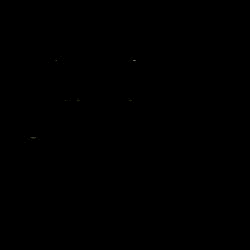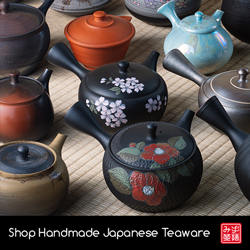 Houjicha is known to have lower levels of caffeine than other Japanese teas. It’s common for children to drink it in Japan because of this notion.
Houjicha is known to have lower levels of caffeine than other Japanese teas. It’s common for children to drink it in Japan because of this notion.
This tea is made by roasting green tea leaves (usually bancha) and although it looks, smells and tastes very different, it’s still considered to be a type of green tea.
Is caffeine content decreased during the roasting process?
Throughout the internet you’ll read that houjicha loses caffeine during the roasting process, because caffeine sublimes (changes from a solid into a gas) at 178°C.
I had seen such statements for so long that I didn’t even think of questioning them. However, when I wanted to find out exactly how much caffeine was lost, I couldn’t find a single study (either in English or Japanese) that explained it!
Thus, I looked into other options to see if I could figure it out.
One abstract from a Chinese university says that there was little difference in the quantity of caffeine in oolong tea for different temperatures in the roasting process. I don’t have access to the main text, so I can’t tell if the sublimation temperature was reached or not.
Another study about the industrial processing of yerba maté found that “caffeine loss (about 20%) in leaves mainly occurred during hot air drying, carried out in two stages, with inlet air temperatures about 110°C”. I’m guessing that it has to do with caffeine being dissolved in water and then being removed in the drying phase?
Finally, I read about roasting levels in coffee and their effect on caffeine. There is a change in the caffeine content, but it’s not a simple answer. The coffee bean changes density (it loses moisture and gains volume).
That means that you’ll get a different result depending if you measure by weight or by volume. A darker roast results in a bean that weights less, but it’s bigger. If you brew by weight it’s more caffeine (since you’ll need more coffee beans than for a light roast), if you do it by volume it would be less.
Anyway, the general consensus is that the change itself isn’t significant at the end, so the roasting process of coffee has no practical effect on the caffeine content.
Comparing caffeine content of different Japanese teas
I then looked at studies that measured the amount of caffeine in different teas. Unsurprisingly, houjicha has less caffeine than sencha and gyokuro. But here’s the surprise: It’s very close to the caffeine level of bancha, and in some cases it’s a little more!
In a study done by the National Food Research Institute of Japan, the percentage of caffeine as a percentage of dry leaf weight was measured for various teas, here’s a short summary:
| Type of tea | Caffeine content % |
|---|---|
| Gyokuro | 3.75 |
| Sencha | 3.07 |
| Bancha | 2.05 |
| Houjicha | 1.95 |
Another paper by Tetsuhisa Goto, who also participated in the previous study, shows these results:
| Type of tea | Caffeine content % |
|---|---|
| Gyokuro | 3.25 |
| Sencha | 2.57 |
| Bancha | 1.55 |
| Houjicha | 1.76 |
Note that these are averages, because each sample’s caffeine content differs. The general trend, however, is the same. Bancha and houjicha have a similar caffeine content.
This is interesting because houjicha is made from bancha, which means that houjicha starts out with less caffeine (as compared to other teas) even before the roasting begins!
There’s more caffeine in young leaves, as opposed to the mature leaves of bancha. Not to mention that bancha and houjicha have a good amount of twigs and stems, which are also low in caffeine.
My conclusion is that houjicha’s roasting process doesn’t play a big part in the amount of caffeine. It would be helpful if someone could share his knowledge with us on this subject.
Sources:
Health Effects of Tea and its Catechins
Contents of Individual Tea Catechins and Caffeine in Japanese Green Tea
Chemical Composition of Japanese Green Teas on Market
Optimization of Oolong Tea (Drinks) by Roasting Model System






April 23, 2014
Another great post with lots of information.
Keep it up, Ricardo.
Thank you.
😉
April 23, 2014
Thanks for the comment Dee.
Hopefully you found it useful.
April 24, 2014
Thank you for such an awesome article! I have been wondering about Houjicha and its caffeine level for a while.
April 24, 2014
hojicha has less caffeine because it made from the tea stalks and not the leaf which is where most of the caffeine is (the leaf)
April 24, 2014
Hello Dylan
Houjicha does have leaves in it. But you’re right, it has more stems and stalks than other teas.
April 27, 2014
wow, this article is great. very clear and thoughtful…also candid with open questions. I will definitely like to try houjicha or bancha. where can u buy? I am in San Francisco
April 27, 2014
Hello Li
Glad that you liked the article.
Both bancha and houjicha are common Japanese teas, so pretty much any tea store that has Japanese teas, either physical or online.
May 8, 2014
I work for a Japanese tea company in the US and may have some insight. Hojicha simply refers to roasted Japanese green tea, which can be anything from 100% leaves, 100% stems, to any ratio in between.
Hojicha loses a lot of mass (water, gases) in the roasting process, but the leaves and stems don’t expand proportionally. So a 250g bag of hojicha is somewhat larger than a 500g of bancha or kukicha, even though it’s less than half the weight.
Since the caffeine doesn’t disappear, it would be proportionally a larger percentage of dry weight. However, you usually only use 1/2 the usual amount of “leaf” to brew hojicha, so a cup of hojicha should still have about half the caffeine as a cup of bancha.
I would still say brewed hojicha has less caffeine than any other tea from Camellia sinensis (that hasn’t been “decaffeinated”).
May 8, 2014
Hello Noli
Thank you for adding some insight.
You’re saying that houjicha’s caffeine content should be proportionally a larger percentage of dry weight. I agree with your logic in that if houjicha had lost mass, but not caffeine, the percentage of caffeine by weight would obviously increase (same caffeine but less mass, so more caffeine percentage).
However, the studies shown above measured a similar caffeine content of bancha and houjicha measured as a percentage of dry weight. In other words, it’s as if the roasting had little effect. Why so much difference between sencha and bancha and little difference between bancha and houjicha?
Yes, brewing is a different story, but I for example use twice the amount of tea by volume when brewing houjicha and bancha. I know that I need more volume because the tea leaves are lighter than for the same volume of sencha. Plus, I’m a tea geek and I sometimes weight the tea to have the right measure when reviewing 🙂
May 9, 2014
In this case, the comparison isn’t fair because the data you have found do not give figures for kukicha. It would also be important to know what percentage of leaf and stem was in the “hojicha.” I still believe reduced mass makes up for the apparent higher caffeine content, especially once stems are accounted for. Unfortunately, as someone from a science background, I find most of the data on Japanese tea to be poorly defined and/or incomplete, making it hard to draw conclusions on problems such as this.
May 9, 2014
Hi Noli
The only study I found that includes kukicha is this one: http://naldc.nal.usda.gov/download/1807/PDF
It doesn’t determine caffeine percentage of dry leaf weight, but instead brews the teas, although at the same method for all teas. In this one kukicha is considerably high in caffeine, houjicha and genmaicha are very low, but there is no bancha. I think that the problem here is that kukicha often comes with tea leaves, and most of the time the kukicha stems are from younger leaves. When you look at bancha stems, some are actually twigs, very thick and course. I speculate that they are also low in caffeine.
My thought is, there’s no bancha that’s 100 percent stems, right? I think that in general, there are more stems in houjicha than in bancha because they don’t look good in bancha but in houjicha they are ok. If someone measured the caffeine in a houjicha, how can he tell that the low caffeine (as compared to sencha) is due to the amount of twigs or the roasting process?
The best way would be for someone to measure caffeine in sencha leaveas and then roast an identical batch and do the same. Hopefully someone will try that one day.
May 9, 2014
Good job finding good articles! However, after looking at the materials they sourced, they consist mostly of low-cost, teabag (I assume) teas. Any box of “sencha” under $4 is almost certainly bancha, and genmaicha is typically made with bancha and rice. (Remember that a 50/50 mix of bancha and rice will have half the caffeine as 100% bancha). So even this study makes it hard to judge the actual relative caffeine content.
We have had caffeine levels tested in some of our teas, but not all because it’s too costly. Maybe when the day comes that we’ve tested all of them, I’ll have some good data to share with you.
May 9, 2014
I’ve read similar conclusions before but never so well thought out and lucidly written. One has to wonder now if the reputed lesser amount and effects of caffeine in houjicha is partly placebo?
May 9, 2014
Thanks for your comment Michael.
Yes, that could be part of the story. Anyway, houjicha is relatively a low caffeine tea, but what many people don’t know is that bancha is low in caffeine to the same extent.
February 15, 2016
As others have said here, you’ve written a fantastic article and I really appreciate all the research and thought youve put into it. Thank you!
February 15, 2016
Thank you John 🙂
July 13, 2017
Really good information here, well-researched too. Thanks for sharing it!
April 25, 2018
This article has a lot of great information, I’ve been curious if there was any scientific basis on the conventional wisdom around hojicha, and this article does a lot to clear things up for me. Most other websites I see just state the minimal caffeine claim with no evidence, so I was always curious where that came from.
Just an FYI, it looks like the tables you included in this article are broken, it’s showing “[table “” not found /]” for me at least.
April 25, 2018
Hi Greg
Thank you for pointing that out, I have updated the tables.
September 19, 2020
That makes a lot of sense. I would have been surprised if the roasting process would actually somehow “destroy” the caffeine, which is otherwise known as a relatively resilient substance. Also, Chinese greens are pan-fried rather than steamed, which would mean that most of them should be low in caffeine, but I don’t see that being the case. There are multiple viable (if I say so myself) explanations as to why houjicha is perceived to be low in caffeine:
1. Green tea just doesn’t contain that much caffeine to begin with, and it brings along L-theanine. So while you do something for your alertness, you also upgrade your chill factor, which can probably make small amounts of caffeine vanish into nonexistence.
2. Green tea is not anywhere as concentrated as coffee, which is almost exhaustively extracted for just one cup. Whereas with a good green you usually get multiple cups and drink for a longer time.
3. Bancha (which is commonly popular for drinking in the evening) and Houjicha contain less caffeine than other teas, making them even less of an offender.
4. Thinking that you didn’t drink a lot of caffeine gives you the mental ability to relax. Whereas thinking “I just had a huge cup of coffee, how should I sleep” magnifies your anxiety.
5. Most people who get this fancy stuff are already used to drinking green tea a lot, and the caffeine doesn’t kick as hard. And certainly not if you’re used to more evil stuff like coffee or Red Bull.
This of course doesn’t mean you should underestimate the Camellia – drinking an oversteeped black or allowing yourself a generous bowl of matcha just before bedtime probably won’t let you shut down the way you deserve.
Sources: My brain et. al., 2008
September 19, 2020
Hi Michael, thank you for your comment.
Regarding Chinese green teas, they are pan fried but it isn’t such a high temperature because otherwise they would be roasted like houjicha. Even Japanese green teas like sencha have a light firing process called hiire when they are refined.
November 19, 2021
Black teas in general don’t tend to contain more caffeine then green. That’s a common myth.
https://www.ncbi.nlm.nih.gov/pmc/articles/PMC4787341/
Oolongs tend to be the lowest in caffeine from the 6 major tea types (white, green, yellow, oolong, black, post-fermented), as they tend to be made with larger leaves,
and bud teas (like white yinzhen for example), tend to be the highest.
Of course the flush, specific cultivar, terroir, etc. also play a role in the caffeine content.
Personally, I find green & white teas in general to be more stimulating and uplifting then black teas though.